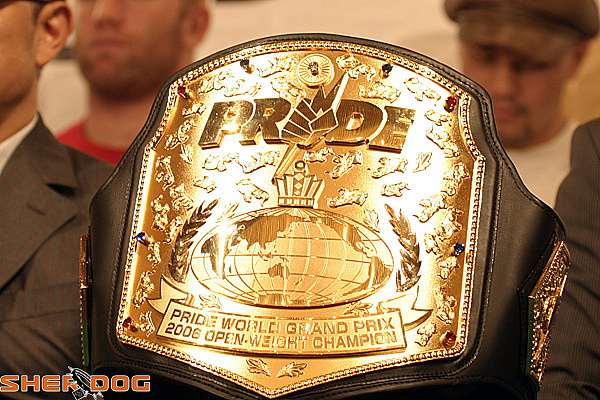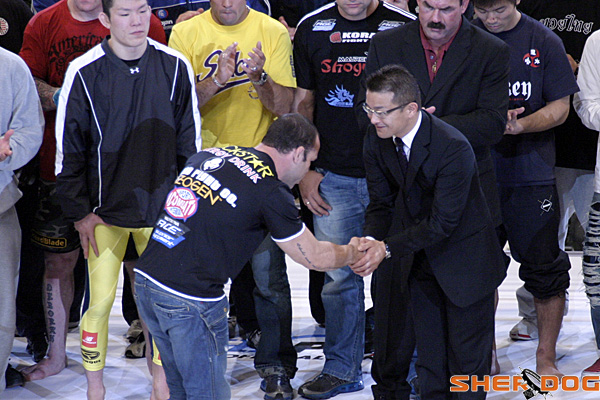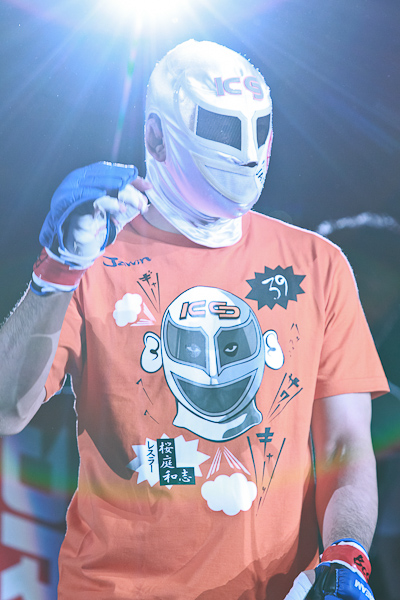MMA At 20: Japan’s Splintered Origins
Confounding Hypocrisy

Pride Fighting Championships held sway over MMA for roughly a
decade. | Photo: Masa Fukui/Sherdog.com
In December 2000, Inoki and Pride worked together for a year-end pro wrestling event at the Osaka Dome. A year later, they teamed up with K-1 to make another year-end show, adding combat sports to Japan’s New Year’s Eve television diet. The money was big, and the ratings were even bigger. As a result of this new business relationship, Inoki rewarded pro wrestlers who engaged in worked or real fights in both Pride and K-1, pushing them as pro wrestling titleholders in the New Japan ring. Not surprisingly, the traditionalists were furious. However, Inoki blurred the lines and was putting himself over on a grand scale. He was truly the king of fighting celebrities.
The major players ran a show together at National Stadium in Tokyo in 2002, attracting more than 70,000 spectators. Sakuraba, the national hero, lost to K-1 superstar Mirko “Cro Cop” Filipovic. “Cro Cop” was an ace of K-1, much like the unstoppable Emelianenko was an ace for Pride. Both men also happened to be managed by Australian power agent and contract lawyer Miro Mijatovic.
Advertisement

Photo:
Stephen Martinez/Sherdog.com
Sakakibara once fronted Pride.
During this same time period, the three key players -- Inoki, K-1, and Pride -- split apart. They each decided to run their own fighting show on New Year’s Eve, the biggest television-watching day of the year in Japan. That is how big the stakes were. K-1 ran with Bob Sapp, a larger-than-life American football player-turned-monster, against former Sumo legend Chad “Akebono” Rowan on Tokyo Broadcasting System. Pride booked Royce against judo legend and 1992 Olympic gold medalist Hidehiko Yoshida on Fuji TV. Inoki booked New Japan pro wrestler Yuji Nagata against Pride heavyweight champion Emelianenko on Nippon TV.
However, Inoki was not actually running the show; that role was
played by a self-admitted yakuza fixer named Seiya Kawamata.
Kawamata and Mijatovic claimed that Pride paid Filipovic to not
fight on Inoki’s show and threatened Mijatovic regarding
Emelianenko’s contractual rights. Mijatovic later claimed Kawamata
stiffed him on money. Kawamata sued Nippon TV the following year
for a canceled New Year’s Eve television contract. To say the
least, the fallout from New Year’s Eve 2003 was calamitous.
Eventually, a complaint was filed with Kanagawa police over Seiya Kawamata being threatened by Pride’s alleged yakuza backers. Kawamata suddenly became a person of critical media interest. Kawamata gave a series of interviews to Japanese magazine “Shukan Gendai” discussing his supposed yakuza dealings in the fight industry and instantly created a blistering firestorm. The negative media campaign soon created pressure against Fuji TV for supporting an alleged yakuza front company like Pride.
In Japan, the hypocrisy surrounding the yakuza is a confounding case of wilful blindness. However, once allegations go public, the outrage is immense.
“Shukan Gendai” printed diagrams and flow charts in its pages, detailing the supposed criminal hierarchy of Pride, allegedly helmed by a shadowy individual called “Mr. I,” an ethnic Korean and Sakakibara backer. The uproar caused by public claims from Kawamata and Mijatovic gave police sufficient cause to raid Fuji TV’s offices and give executives an ultimatum regarding the future of Pride on network television. Despite wildly successful television ratings, Fuji TV pulled the plug on Pride and DSE in June 2006. “Shukan Gendai” later claimed that Mr. I returned to South Korea following the scandal.
Meanwhile, Inoki, dealing with a hornet’s nest of a pro wrestling operation, sold the assets of New Japan Pro-Wrestling to video game company Yukes. Inoki still had a symbolic presence in the sport, but his power was gone. Yukes was left to clean up his mess of an organization and returned NJPW back to a more traditional wrestling operation.

Photo:
Taro Irei/Sherdog.com
Sakuraba was an unlikely MMA superstar.
Right before Pride lost its contract with Fuji TV, company ace Sakuraba jumped ship to K-1 and its Hero’s MMA league.
Sakuraba, along with enfant terrible Norifumi “Kid” Yamamoto, gave the league some star power, but the project largely did not accomplish what Kazuyoshi Ishii and matchmaker Sadaharu Tanigawa thought it would.
The master plan for K-1 officials in the post-Pride era was simple: since they controlled the broadcast television pipeline in Japan, any promoter that wanted to do something on a big scale had to work with them. K-1 was interested in the TV money in exchange for putting the responsibility of the live gate on promoters. However, K-1’s grand plan had a major flaw. The plan worked in theory, as long as you were continuing to draw big television ratings. The problem: in the post-Pride era, K-1’s TV ratings for both its kickboxing and MMA properties started declining. Network television support for K-1 waned, as well. K-1 eventually lost television support, and the organization died a drawn-out, inglorious death, with assets being sold to Japanese real estate firm Barbizon Corporation Limited in July 2011.
Recent anti-yakuza laws in Japan have applied major pressure on the gangs. The lack of yakuza cash and network television support has crippled the MMA scene on a large scale in Japan. Companies like Shooto and Pancrase continue to promote and turn out fighters, but it is expected that the nation’s best have their eyes set on the UFC. Many simply remain hopeful that an interesting or charismatic Japanese athlete will reinvigorate the market. As of now, there is not one in sight.
The one common denominator in the history of the Japanese combat sports boom was Inoki. Now at age 70, he is trying to get back into politics. Perhaps even the Godfather sees the writing on the wall.
Related Articles







